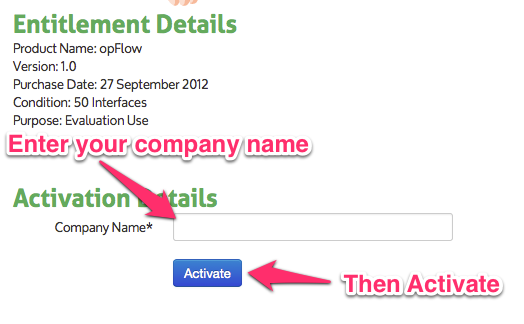...
Open your favourite web browser and navigate to:
| Code Block |
|---|
http://servervm_ip_address/cgi-nmis8/nmiscgi.pl |
User: nmis
Password: nm1888
5. Configuring Modules
The first step to using a module is knowing how to open it, the next is to get a license for it. This process is simple and painless, if you would just like to try the software trial licenses are available!
Before you begin we will make sure all the permissions are correct so everything goes smoothly, this is very important:
| Code Block |
|---|
/usr/local/opmantek/bin/opfixperms.pl |
Should produce the following output:
| Code Block |
|---|
opfixperms.pl Version 1.0
Copyright (C) 2012 Opmantek Limited (www.opmantek.com)
This program comes with ABSOLUTELY NO WARRANTY;
See www.opmantek.com or email contact@opmantek.com
This script will fix the permissions for Opmantek based on the configuration /usr/local/opmantek/bin/../conf/opCommon.nmis
The directory to be processed is: /usr/local/opmantek
The user will be set to: nmis
The group will be set to: nmis |
Now let's get started!
Opening a module
There are two ways to open the modules, by using the drop-down in the NMIS page (make sure you do not have pop-up's blocked for this page):
or by manually entering the url into your browser:
| Code Block |
|---|
http://vm_ip_address/cgi-omk/opFlow.pl |
Getting a trial license
opFlow, opMaps and opReports will present you with a page that looks like the following when not registered:
As the image suggests, to get and enter a license key it is easiest to click the "View and Entere Licenses" button. This will open a new tab/page containing the opLicensing module. On this page you will again need to click a button, it's time to choose if you want a trial license or if you would like to buy a license.
This will bring you to https://opmantek.com, here you will need to sign up for an account with us by Joining our Community.
Now you can fill out the form and register. After registering, go to the products page and select either "Free Trial License" or "Buy License." For now I will assume you have selected to get a free trial license.
Next you will need to select the products you would like to get a license for, and then click "Get Trials"
The licenses will now be created and added to your account. Click "View License" to see your licenses and activate them.
Now we will activate our license.
Enter your company name and then select "Activate"
You will now be presented with your license key for the product you selected. You will now want to select the key text (right click -> select all) and copy it to the clipboard (right click on selected text -> copy)
Now it's time to return to the opLicense tab and click "Enter a License Key"
Paste the license key into the textbox provided and click "Add License". IMPORTANT: before you click "Add License" make sure you have done this step:
| Code Block |
|---|
/usr/local/opmantek/bin/opfixperms.pl |
You should now have a sucessfully installed key!
Now return to the tab/window of the module you were activating and click "License Entered, Continue"
Accept the EULA:
And you're Done! The next step is to make sure the configuration for the module you activated is correct & complete.
opFlow Configuration
Mongo
The first step to get opFlow working is to start the mongo database. The VM already has mongo installed and all the scripts are ready to go, first we will add the mongo script to the VM's startup routine, and then we will start the daemon.
| Code Block |
|---|
chkconfig mongod on
service mongod start |
Note: the first time you start mongo it may take a while to return to the command prompt, don't worry about it, just let mongo run and it will eventually come back, if it doesn't CTRL+C and start it again.
Flowd
flowd should be running, but to be sure we will take the same steps as we did with mongo.
| Code Block |
|---|
chkconfig flowd on
service flowd start |
When you run the start command you will likely see an error like the following which tells you it's already running, of course you could always use ps to find out as well
| Code Block |
|---|
Starting flowd: bind: Address already in use
Listener setup of [0.0.0.0]:12345 failed |
opFlowd
opflowd also needs the same treatment:
| Code Block |
|---|
chkconfig opflowd on
service opflowd start |
Configure your Cisco Router
I will discuss a very basic configuration.
On the interface you want to collect flow traffic from, add:
| Code Block |
|---|
ip flow ingress
ip flow egress |
Now that you have an interface setup to gather netflow information you have to tell the router to send it somewhere:
| Code Block |
|---|
ip flow-export version 9
# replace the ip address in the following line with your VM's ip address
ip flow-export destination 192.168.0.10 12345 |
If you enable that configuration netflow traffic should now be sent to your VM.
By default netflow will send information about flows after they are finished, if you would like to see information more often you can set the flow-cache timeout, in minutes, so this will send flow info every minute (see the docs for more details):
| Code Block |
|---|
ip flow-cache timeout active 1 |
Run setup script
./opflow_setup.pl setup=all
opFlow will now be displaying your data! Visit http://vm_ip_address/cgi-omk/opFlow.pl and take a look! (also make sure you have a license)














